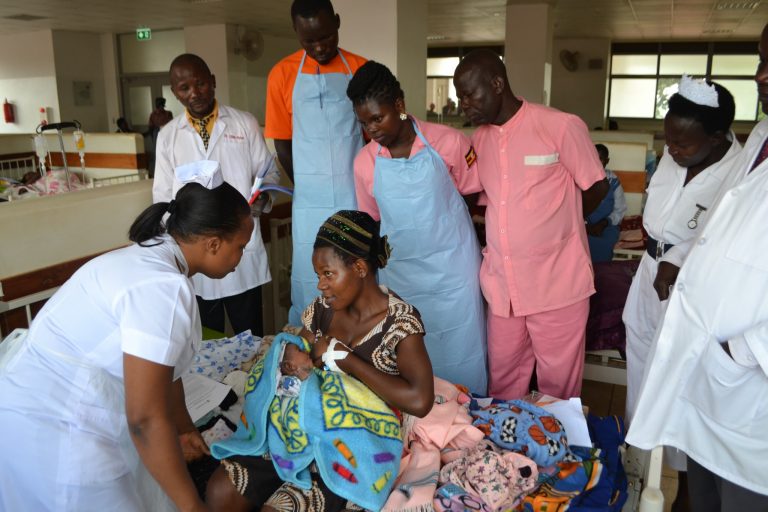Access to facility-based maternal newborn health (MNH) care and services has vastly improved in several countries and settings over the last decade, and the focus has shifted to quality improvement efforts and initiatives in order to end preventable maternal and newborn deaths. As such, many countries are investigating ways to optimize facility readiness, increase health worker knowledge and confidence, and ultimately improve quality and coverage of MNH care practices.
From 2016 to 2017, Uganda’s Ministry of Health (MOH) with support from Save the Children and the University Research Company (URC) piloted the Regional Learning Network initiative (RLN), a quality improvement collaborative, in the Hoima Region. The RLN and referral system linked 14 health facilities, including the Hoima Regional Referral Hospital, with the aim to improve the survival and health of mothers and their babies.
The initiative had three objectives: 1) employ QI methodology, including a training lab based at the regional referral hospital to address critical gaps in providing high-quality MNH care; 2) produce new knowledge and learning on best approaches to improve MNH care; and 3) share and document learning with other Regional Referral Hospitals and lower-level facilities. Save the Children and URC examined the extent to which the RLN improved clinical outcomes and processes of care as well as how referral networks and network-building activities functioned during the course of the project.
Save the Children has prepared a brief detailing the work and lessons learned from the RLN in the hopes that it can provide useful insight to health facilities, MOHs and other partners seeking to establish or strengthen regional referral networks and quality of care.
Main findings
The assessment found that the RLN improved facility readiness to support essential obstetric and newborn services, including increased availability of basic newborn care units, reduced frequency of stock-outs of drugs and supplies, and increased health worker knowledge and confidence in key competencies, and improved documentation of care. As such, the quality and coverage of newborn care practices improved, such as early initiation of breastfeeding from 12% to 81%, Kangaroo Mother Care (KMC) Initiation from 7% to 65% and babies weighed at birth from 25% to 100%.
Overall, staff perceived the RLN to be effective at improving communication, strengthening health worker knowledge and fostering a culture of learning, district governance, and use of data for accountability. Health workers and managers found the skills lab and learning sessions established by the RLN as the most beneficial of all project activities. Some perceptions between regional and district level leadership and frontline health workers’ differed especially around health worker knowledge on the referral process and guidelines.
These two quotes reflect some of the main findings:
“The learning sessions have helped us greatly in attitude change of the health workers. There are some things which we used to think are very impossible they cannot happen. But when you go and find it working elsewhere you greatly change your attitude as a health worker.” (IDI, District Health Management Team member)
“A lot has changed…many facilities did not have equipment for the newborn…health workers lacked knowledge on how to care for these babies and I think that has changed a lot. We have received equipment and now the health workers know how to use them.” (IDI, Quality Improvement Officer)
Key lessons
Key focus areas for improving quality of care include engaging and investing in local clinical leadership, continuous skills building, and strengthening appropriate communication and referral systems between facilities. Efforts put into network and relationship building, as well as mentorship and information to increase health worker confidence, led to improvement in knowledge of referral conditions and reduction in the number of unnecessary referrals made to Hoima RRH from lower level facilities.
Investing and engaging local clinical leadership on quality improvement initiatives at the start supports sustainability and scalability of the RLN model. However, efforts to ensure sustainability and address the gaps in leadership and frontline workers’ perception were not fully realized during the duration of the project. Longer-term investment in terms of funding ongoing activities and oversight should be considered in the future.

Recommendations for Ministries of Health and implementing partners looking to establish a Regional Learning Network:
- Engage and invest in local clinical leadership to ensure sustainability and scalability.
- Provide continuous opportunities for health workers to improve clinical and QI skills e.g. a skills-building lab at the Referral Hospital available to all staff in region.
- Ensure availability of appropriate communication, referral systems, supplies, commodities, and infrastructure to support essential obstetric and newborn services.
- District level buy-in, as well as leadership and governance, is invaluable for national expansion. By enabling joint planning, District Coordination Committees can address health system barriers.
- Provide longer term investment to ensure sustainability and address gaps in perceptions of project goals and achievements between Ministry-level leadership and frontline workers.
- Ensure sustained resources for quality improvement efforts.
Access the brief, including additional information about the initiative and How-To guides for establishing a Regional Learning Network here.
Acknowledgements
The brief was written using the documentation and evaluations from multiple unpublished project reports. Those who contributed to the research, interpretation, writing and process documentation include:
- Center for Human Services/University Research Co., LLC team: Jorge Hermida, Richard Kagimu-Musoke, Juliet Namukasa, Hussein Kato, and Anjali Chowfla.
- SC Uganda SNL team: Berina Kamahoro, Richard Mayanja, Sam Ongom, Patricia Pirio.
- Save the Children US team: Lauren DuComb, Samantha Herrera, Mary Kinney, Lydie Ky, Bina Valsangkar, Lara Vaz, Lyndsey Wilson-Williams.
- Consultants: Erica Corbett, Jolly Beyeza-Kashesya, Tom Ediamu.
